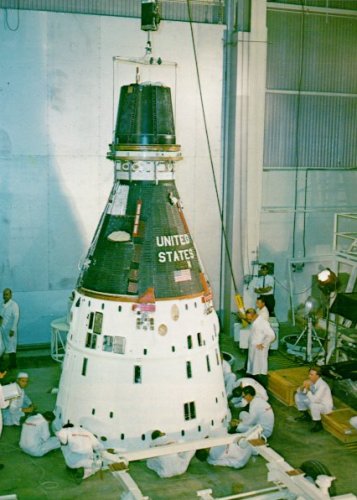Apollo Expeditions to the Moon
GEMINI PROGRAM
The Gemini program was designed to investigate in actual flight many of the
critical situations which we would face later in the voyage of Apollo. The spacecraft
carried an onboard propulsion system for maneuvering in Earth orbit. A guidance and
navigation system and a rendezvous radar were provided to permit astronauts to try
out various techniques of rendezvous and docking with an Agena target vehicle. After
docking, the astronauts could light off the Agena rocket for large changes in orbit,
simulating the entry-into-lunar-orbit and the return-to-Earth burns of Apollo. Gemini
was the first to use the controlled reentry system that was required for Apollo in
returning from the Moon. It had latches that could be opened and closed in space to
permit extravehicular activity by astronauts, and fuel cells similar in purpose to those
of Apollo to permit flights of long duration. The spacecraft was small by Apollo standards,
carrying only two men in close quarters. However, the Titan II launch vehicle,
which was the best available at that time, could not manage a larger payload.
| | |
Early proposals for manned space vehicles varied
greatly in configuration and weight. In some, the men
within faced one way during launch and another during
reentry; in others, the vehicle was turned around,
not the seats. Different approaches to the problem of
escape from launching disaster were shown in these
six industrial proposals. Environmental control,
thermal and radiation shielding, and protection
against meteorite impact were all unknowns facing
early spacecraft designers.
|
| | |
A one-man lunar lander weighing 5000 pounds was
envisioned as early as 1961 by a pair of Space Task
Group engineers, James A. Chamberlin and James T.
Ross, and here drawn by Harry A. Shoaf. It was seen
as part of a 35,000-pound payload that might be carried
by a post-Mercury spacecraft. The other extreme
in early ideas to send men to the Moon called for a
direct-ascent manned lunar vehicle weighing some
150,000 pounds. It would have been launched by
Nova, a giant booster capable (on paper) of
approximately 12 million pounds of thrust.
|
A total of 10 manned flights were made in the Gemini program between March
1965 and November 1966. They gave us nearly 2000 man-hours in space and developed
the rendezvous and docking techniques essential to Apollo. By burning the Agena
rockets after docking, we were able to go to altitudes of more than 800 nautical miles
and prove the feasibility of the precise space maneuvers essential to Apollo. Our first
experience in EVA was obtained with Gemini and difficulties here early in the program
paved the way for the smoothly working EVA systems used later on the Moon. The
Borman and Lovell flight, Gemini VII, showed us that durations up to two weeks were
possible without serious medical problems, and the later flights showed the importance
of neutral buoyancy training in preparation of zero-gravity operations outside the
spacecraft.
Gemini gave us the confidence we needed in complex space operations, and it
was during this period that Chris Kraft and his team really made spaceflight operational.
They devised superb techniques for flight management, and Mission Control
developed to where it was really ready for the complex Apollo missions. Chris Kraft,
Deke Slayton, head of the astronauts, and Dr. Berry, our head of Medical Operations,
learned to work together as a team. Finally, the success of these operations and the
high spaceflight activity kept public interest at a peak, giving our national leaders the
broad supporting interest and general approval that made it possible to press ahead
with a program of the scale of Apollo.

|
This Gemini spacecraft, in preparation in
the Pyrotechnical Installation Building at
the Cape, was to climb to a record altitude
of 853 miles in September 1966. It docked
in space with an Agena, and then used the
big Agena rocket for the energy needed
to reach the larger orbit. Gemini flights
provided priceless experience in the tricky
business of rendezvousing two craft in
space with the minimum expenditure of
energy. They also supplied practice at
docking and in extravehicular activity,
both needed for future Moon voyages.
Finally, they helped build up experience
with the mission-control system developing
on the ground to support manned spaceflight.
|
| | |
The two-man Gemini seemed capacious
after tiny Mercury but it was actually very
cramped. The astronauts rubbed elbows,
and the man in the right seat, returning
after EVA with his bulky spacesuit and
tether, had to jam himself in to close the
hatch over his head. |
|




